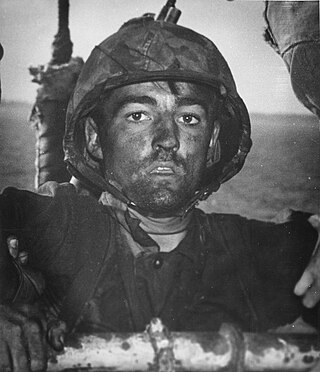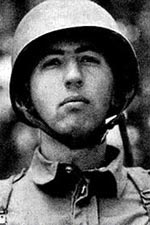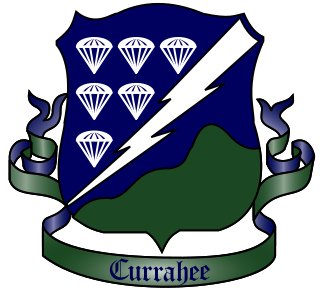Post-traumatic stress disorder (PTSD) is a mental and behavioral disorder that develops from experiencing a traumatic event, such as sexual assault, warfare, traffic collisions, child abuse, domestic violence, or other threats on a person's life or well-being. Symptoms may include disturbing thoughts, feelings, or dreams related to the events, mental or physical distress to trauma-related cues, attempts to avoid trauma-related cues, alterations in the way a person thinks and feels, and an increase in the fight-or-flight response. These symptoms last for more than a month after the event. Young children are less likely to show distress, but instead may express their memories through play. A person with PTSD is at a higher risk of suicide and intentional self-harm.
A company is a military unit, typically consisting of 100–250 soldiers and usually commanded by a major or a captain. Most companies are formed of three to seven platoons, although the exact number may vary by country, unit type, and structure.

Military ranks are a system of hierarchical relationships, within armed forces, police, intelligence agencies or other institutions organized along military lines. The military rank system defines dominance, authority, and responsibility in a military hierarchy. It incorporates the principles of exercising power and authority into the military chain of command—the succession of commanders superior to subordinates through which command is exercised. The military chain of command constructs an important component for organized collective action.

Fragging is the deliberate or attempted killing of a soldier, usually a superior, by a fellow soldier. U.S. military personnel coined the word during the Vietnam War, when such killings were most often committed or attempted with a fragmentation grenade, to make it appear that the killing was accidental or during combat with the enemy. The term fragging now encompasses any deliberate killing of military colleagues.

Depersonalization can consist of a detachment within the self, regarding one's mind or body, or being a detached observer of oneself. Subjects feel they have changed and that the world has become vague, dreamlike, less real, lacking in significance or being outside reality while looking in. It can be described as feeling like one is on "autopilot" and that the person's sense of individuality or selfhood has been hindered or suppressed.

Combat stress reaction (CSR) is acute behavioral disorganization as a direct result of the trauma of war. Also known as "combat fatigue", "battle fatigue", or "battle neurosis", it has some overlap with the diagnosis of acute stress reaction used in civilian psychiatry. It is historically linked to shell shock and can sometimes precurse post-traumatic stress disorder.
Ganser syndrome is a rare dissociative disorder characterized by nonsensical or wrong answers to questions and other dissociative symptoms such as fugue, amnesia or conversion disorder, often with visual pseudohallucinations and a decreased state of consciousness. The syndrome has also been called nonsense syndrome, balderdash syndrome, syndrome of approximate answers, hysterical pseudodementia or prison psychosis.

Peter Pan Syndrome is a pop-psychology term used to describe an adult who is socially immature. It refers to “never-growing” adults who have reached an adult age, but cannot face their adult sensations and responsibilities. It is a metaphor, based on the concept of not growing up and being trapped in childhood. Individuals with Peter Pan Syndrome display behaviours associated with immaturity and a reluctance to grow up. They have difficulties in social and professional relationships because of their irresponsible behaviours and narcissistic properties. While it has often only been associated with males in the past, it can affect anyone, regardless of sex or gender.
The syndrome of subjective doubles is a rare delusional misidentification syndrome in which a person experiences the delusion that they have a double or Doppelgänger with the same appearance, but usually with different character traits, that is leading a life of its own. The syndrome is also called the syndrome of doubles of the self, delusion of subjective doubles, or simply subjective doubles. Sometimes, the patient is under the impression that there is more than one double. A double may be projected onto any person, from a stranger to a family member.

Herbert Maxwell Sobel was an American soldier who served as a commissioned officer with Easy Company, 2nd Battalion, 506th Parachute Infantry Regiment, in the 101st Airborne Division during World War II. Sobel's story was featured in historian Stephen E. Ambrose's book Band of Brothers, and he was portrayed by David Schwimmer in the HBO miniseries of the same name.
Post-concussion syndrome (PCS), also known as persisting symptoms after concussion, is a set of symptoms that may continue for weeks, months, years after a concussion. PCS is medically classified as a mild traumatic brain injury (TBI). About 35% of people with concussion experience persistent or prolonged symptoms 3 to 6 months after injury. Prolonged concussion is defined as having concussion symptoms for over four weeks following the first accident in youth and for weeks or months in adults.

E Company, 2nd Battalion of the 506th Parachute Infantry Regiment of the 101st Airborne Division, the "Screaming Eagles", is a company in the United States Army. The company was referred to as "Easy" after the radio call for "E" in the phonetic alphabet used during World War II. The experiences of its members during that war are the subject of the 1992 book Band of Brothers by historian Stephen Ambrose and the 2001 HBO miniseries of the same name.
Rape trauma syndrome (RTS) is the psychological trauma experienced by a rape survivor that includes disruptions to normal physical, emotional, cognitive, and interpersonal behavior. The theory was first described by nurse Ann Wolbert Burgess and sociologist Lynda Lytle Holmstrom in 1974.

Mass psychogenic illness (MPI), also called mass sociogenic illness, mass psychogenic disorder, epidemic hysteria or mass hysteria, involves the spread of illness symptoms through a population where there is no infectious agent responsible for contagion. It is the rapid spread of illness signs and symptoms affecting members of a cohesive group, originating from a nervous system disturbance involving excitation, loss, or alteration of function, whereby physical complaints that are exhibited unconsciously have no corresponding organic causes that are known.

Shell shock is a term that originated during World War I to describe the type of post-traumatic stress disorder (PTSD) that many soldiers experienced during the war, before PTSD was officially recognized. It is a reaction to the intensity of the bombardment and fighting that produced a helplessness, which could manifest as panic, fear, flight, or an inability to reason, sleep, walk, or talk.
Somatic symptom disorder, also known as somatoform disorder, is defined by one or more chronic physical symptoms that coincide with excessive and maladaptive thoughts, emotions, and behaviors connected to those symptoms. The symptoms are not deliberately produced or feigned, and they may or may not coexist with a known medical ailment.

A prisoner is a person who is deprived of liberty against their will. This can be by confinement or captivity in a prison, or forcible restraint. The term usually applies to one serving a sentence in prison.

Civil Resettlement Units, or CRUs, was a scheme created during the Second World War by Royal Army Medical Corps psychiatrists to help British Army servicemen who had been prisoners of war (POWs) to return to civilian life, and to help their families and communities to adjust to having them back. Units were set up across Britain from 1945 and later expanded to provide for Far East Prisoners of War (FEPOWs) as well as those who had been captive in European camps. By March 1947, 19,000 European POWs and 4,500 FEPOWs had attended a unit.

The Cuban Revolution of 1933, also called the Sergeants' Revolt, was a coup d'etat that occurred in Cuba in September 1933. It began as a revolt of sergeants and enlisted men in the military, who soon allied with student activists in the Directorio Estudiantil Universitario.

Post-traumatic stress disorder (PTSD) results after experiencing or witnessing a terrifying event which later leads to mental health problems. This disorder has always existed but has only been recognized as a psychological disorder within the past forty years. Before receiving its official diagnosis in 1980, when it was published in the third edition of the Diagnostic and Statistical Manual of Mental Disorders (DSM-lll), Post-traumatic stress disorder was more commonly known as soldier's heart, irritable heart, or shell shock. Shell shock and war neuroses were coined during World War I when symptoms began to be more commonly recognized among many of the soldiers that had experienced similar traumas. By World War II, these symptoms were identified as combat stress reaction or battle fatigue. In the first edition of the Diagnostic and Statistical Manual of Mental Disorders (DSM-I), post-traumatic stress disorder was called gross stress reaction which was explained as prolonged stress due to a traumatic event. Upon further study of this disorder in World War II veterans, psychologists realized that their symptoms were long-lasting and went beyond an anxiety disorder. Thus, through the effects of World War II, post-traumatic stress disorder was eventually recognized as an official disorder in 1980.












